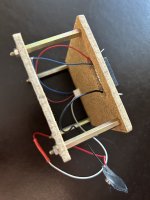Here we go. Made a little interconnect bridge for the 4-wire internal cabling to be 3-wire with common zero. The sense wiring also goes to this point. From this it splits to dual 3-wire for the crossover and an extra buffer for the
 miniDSP/sub management signal. That board is still to be made on experiment board. Also attached a ground lug if I want zero connected to PE. Carving made with a hobby knife and electronic screwdriver. MDF is soft. Fire saftey does not apply to breadboarding, right? 😉 Still waiting for the sinks to be shipped from Germany so it’ll be some SSLV populating and other small works in the meentime.
miniDSP/sub management signal. That board is still to be made on experiment board. Also attached a ground lug if I want zero connected to PE. Carving made with a hobby knife and electronic screwdriver. MDF is soft. Fire saftey does not apply to breadboarding, right? 😉 Still waiting for the sinks to be shipped from Germany so it’ll be some SSLV populating and other small works in the meentime.
Did finish up the tx box today. Its ready for use a while when I test this configuration. My plan is to build and evaluate some different crossover types and setups. I have two way main fullrange speakers, Beyma 15XA38nd in tqwt and two subs that might be four if needed for even distribution in my somewhat diffucult room. I have changed my setup from speakers in corner that gave effective rear wall bass cancellation (hopeless) to me sitting near the back wall and speakers near mid room. 15 m signal cabling goes in walls, one passing a big electrical distribution panel so I need balanced signal cabling to avoid picking up trash. Now since I have good base and decent conditions for music listening I have started working on new gear. I didnt like any passive filter that I could make so I started biamping with active x-over, which suited the tqwts good. First I used miniDSP but I am not ready for ad-da yet on the fullrange. I like it analog. Subs can have that. I have used a lousy dbx 234xs as crossover to a Sonifex RB-UL4 as balancer for initial tests and it works for testing but is not at all musical and makes noice so I almost hear it in listening position. Hence, since life allows me to diy some again I have started to replace the stuff. First off naturally active filter, and ESP was an easy start since I had it unbuilt in a drawer. With this I am going to start running two way witout subs and work with cabinet damping. The tqwts were way to messy in the mids without proper damping. After that I’ll plug in the miniDSP for the subs and evaluate if I will run the tqwts fullrange with subs as support or cut them from lowest (crossing 3-way). Then onwards building more crossovers, hopefully with discrete components. Thats the story and my little diy plan.


Since I build a new box I took the opportunity to add some outlets for the other gear and get rid of the ugly branch outlet. From right to left 230 in, ungrounded white cable for Bluesound network player, 230 outlet for Sonifex, 230 outlet for miniDSP, yellow ground connection to crossover box and an old computer psu cable for 2x21,5 volt raw dc to crossover box.
Since I build a new box I took the opportunity to add some outlets for the other gear and get rid of the ugly branch outlet. From right to left 230 in, ungrounded white cable for Bluesound network player, 230 outlet for Sonifex, 230 outlet for miniDSP, yellow ground connection to crossover box and an old computer psu cable for 2x21,5 volt raw dc to crossover box.
Last edited:
Thanks. I am trying to figure out values to end up with a pot with lowest value practical so that i can reach 15 volts but also mayby adjust down a bit. It will depend on the 117s Idss I guess.

Matched 10+ years ago. Will a DCA75 PRO give me decent values or should I set up a rig?
Matched 10+ years ago. Will a DCA75 PRO give me decent values or should I set up a rig?
DCA will use 3V or so VDS. It will be consistent for IDSS between samples. 10V VDS datasheet rig test will show more IDSS for all of them but their strength order won't change.
In any case IDSS when put in the Vref will be the least obtained. Due to low VDS available in the specific circuit position.
In any case IDSS when put in the Vref will be the least obtained. Due to low VDS available in the specific circuit position.
Thanks. Is it this one you refer to? http://www.diamondstar.de/transistor_matching_jfet.html
I can do some tests with temporary rig and see if the values is consistent with 10y ago. Red leds earlier matched were consistent in relative strength but I probably used more current back then because I get ca 40 mV lower now.
I can do some tests with temporary rig and see if the values is consistent with 10y ago. Red leds earlier matched were consistent in relative strength but I probably used more current back then because I get ca 40 mV lower now.
- Home
- Amplifiers
- Power Supplies
- SSLV1.1 builds & fairy tales
